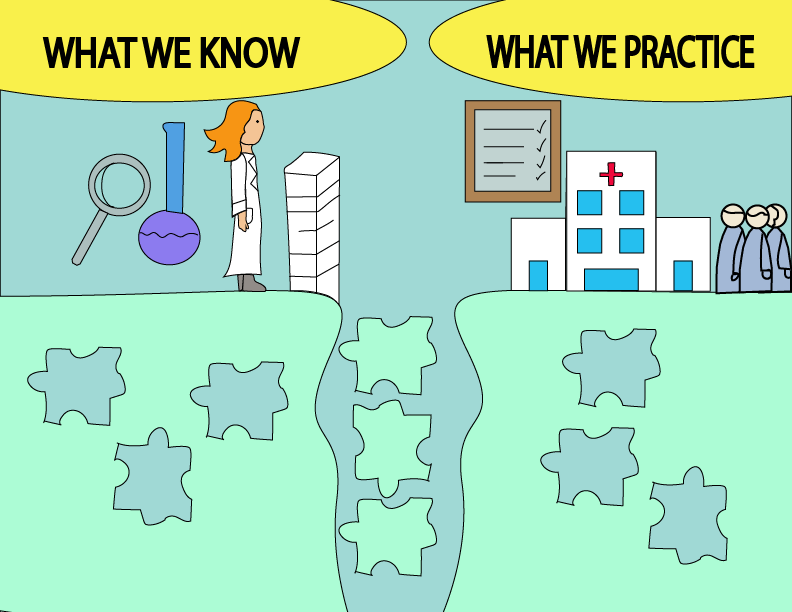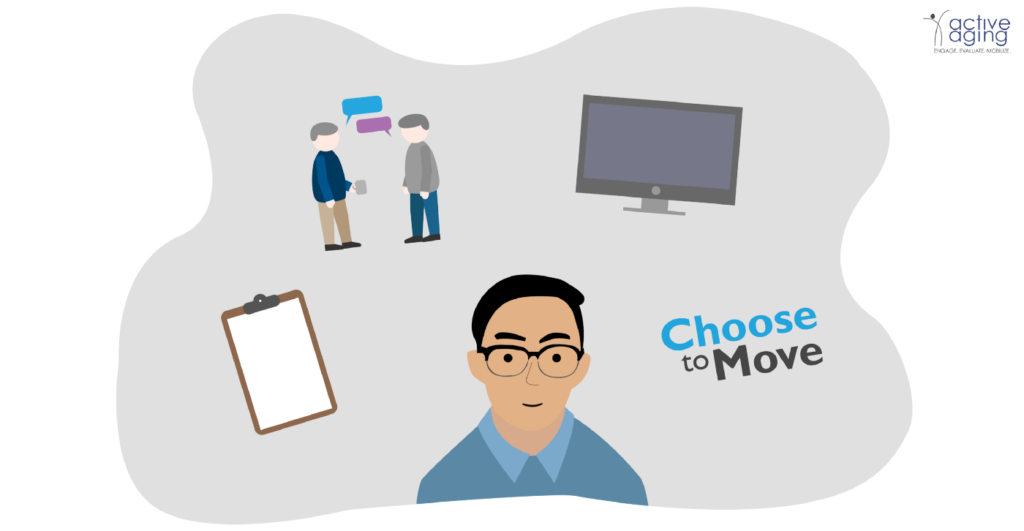By: Renmart Buhay | Biomedical Physiology Co-op Student
Did you know it takes on average 17 years for research to become general practice in the healthcare system? (Green, 2008). When I first heard this I wasn’t too surprised.
During my studies, I often found it difficult to picture how what I was learning could impact people in real-world settings. Now, as I finish my 8-month co-op placement with UBC’s Active Aging Research Team, I can see just how research affects our day-to-day lives. I saw this impact as part of the evaluation team for the province-wide Choose to Move (CTM) program. Choose to Move is an evidence-based health promotion program that is scaling-up across British Columbia with support from the BC Ministry of Health and community partners. It aims to improve the physical activity, mobility, and social connectedness of inactive people aged 65 years and older. Choose to Move is a choice-based model with activity coaching and group meeting components to ensure its adaptability to the interests, needs, and resources of the individual and community.

Work Experience
In a typical workweek, I participated in data management, participant phone calls, and mail-outs of province-wide participant surveys. Outside the office, I travelled to community and YMCA recreation centres in the lower mainland to observe group meetings, administer questionnaires, and conduct physical measurements, such as strength, balance, and mobility tests.
Another highlight of my experience was my involvement with the Arbutus Greenway Evaluation (AGE), which looks at how the built and social environment of the Arbutus Greenway impacts the people using it. The evaluation will provide information to the City of Vancouver, who could implement changes that directly benefit users of the Greenway. Through this project I learned qualitative research skills such as, note-taking, identifying and categorizing interview themes from residents’ experiences using the Greenway. Getting involved in these health interventions was exciting as I was able to have a key role in research that was positively impacting people’s day-to-day lives.
It was through these experiences that I was first exposed to the world of implementation science. What is implementation science you ask? One definition states, it is “the study of methods to promote the integration of evidence into policy and healthcare policy,” (Moreno-Casbas, 2015). An example of implementation science is the Action Schools! BC, a health promotion program that spread across elementary schools in BC to promote physical activity and healthy eating. Researchers, parents and school staff partnered together to implement this program in the school setting using previous research on the active school model. If you went to elementary school in BC, and you remember having physical activity breaks during your classes and playing with bins of sports equipment, then you probably participated in Action Schools. I’m excited by implementation science because of the impact it has on improving our population health.
Reflections
During university, one of the problems I came across was not seeing how the theory and knowledge I was learning was applicable to real life. I was looking for more experiential opportunities in my degree. This co-op experience met my expectations and more. I had the opportunity to see research in action, and meet implementation scientists who were bridging this “know-do gap” in older adult research. Choose to Move is important because it mobilizes and connects researchers and community to address the needs of older adults.

One of the frustrations I often see in research is this long lag time for evidence-based knowledge to reach the general public. In the world of implementation science, knowledge can be quickly spread and sustained in partnership with communities. That is why I enjoyed working on Choose to Move because it involves communities in the design of how the program is implemented. Here research and community work together, which, I often find missing in academia.
Relationships
One of the biggest lessons I learned was the importance of relationships. I saw first-hand how spreading evidence-based knowledge requires trust and good communication between different stakeholders and partners. Working with teams and partners requires clear communication. In my case, I was nervous at first, working in a team with scientists, graduate students and communication managers. My worries disappeared as I had such a great close-knit working environment where I was able to enjoy working with people of different disciplines and learn new skills.
Knowledge Translation
As a research assistant, a part of my role was contributing to knowledge translation, being able to convey research clearly to the general public. Whether it was interacting with participants in person or on the phone, observing group meetings or producing Facebook posts, I played a role in being a science communicator. My assumptions about older adults changed as I interacted more with them. Many were lively, independent, talkative, and motivated to start a change in their lives for the better. Personally I was most touched hearing about why they took part in the program and enjoyed hearing their success stories.
Takeaways
Looking back at my time with the Active Aging Research Team, I saw first-hand how important relationship-building is for spreading knowledge across communities. Choose to Move champions this relationship-building by involving communities in its research and implementation process. Service providers and researchers don’t have all the solutions, so including communities, or the knowledge user, is important. In the field of implementation science, social connection is essential. It is only by building relationships that interventions like Choose to Move can be successful. Moving forward in my research journey, I hope to bring all these learnings with me to value community connections and being an effective communicator.
References
Bauman, A., Gray, S., Hoy, C., Lau, E., McKay, H., Nettlefold, L., Sims-Gould, J. (2018). Implementation of a co-designed physical activity program for older adults: positive impact when delivered at scale. BMC Public Health, 18(1289): 1–15. https://doi.org/10.1186/s12889-018-6210-2
Green, L. (2008). Making research relevant: if it is an evidence-based practice, where’s the practice-based evidence? Family Practice, 25(1): 21–22. https://doi.org/10.1093/fampra/cmn055
Macdonald, H., McKay, H., Naylor, P., Reed, K., Zebedee, J., (2006). Lessons learned from Action Schools! BC — –An ‘active school’ model to promote physical activity in elementary schools. Journal of Science and Medicine in Sport, 9: 413–423. DOI: 10.1016/j.jsams.2006.06.013
Moreno-Casbas, T. (2015). Perspectives: Implementation strategies to adopt and integrate evidence-based nursing. What are we doing? Journal of Research in Nursing, 20(8): 729–730. DOI: 10.1177/1744987115619800

